We’re living in an era where sustainability meets style and our living rooms have become the perfect canvas for eco-friendly transformations. Converting your living space into an environmentally conscious haven doesn’t mean sacrificing comfort or aesthetics – it’s about making smart choices that benefit both your family and the planet.
From energy-efficient lighting answers to sustainable furniture options we’ve discovered countless ways to reduce our carbon footprint while creating stunning interiors. The best part? Many of these green living room ideas actually save money in the long run while improving indoor air quality and overall wellness.
Whether you’re planning a complete living room makeover or looking for simple eco-friendly swaps we’ll show you how small changes can make a important environmental impact. Ready to transform your space into a green sanctuary that reflects your values without compromising on style?
Add Indoor Plants to Purify Air and Enhance Aesthetics
Building on sustainable living room transformations, we can naturally enhance air quality while creating visual appeal through strategic plant placement. Indoor plants offer one of the most effective ways to combine environmental benefits with aesthetic improvements in our living spaces.
Choose Low-Maintenance Plants for Easy Care
Low-maintenance plants provide the perfect starting point for incorporating greenery into our living rooms without overwhelming our schedules. Snake plants (Sansevieria) thrive in low light conditions and require watering only every 2-3 weeks, making them ideal for busy households. Pothos plants adapt to various lighting conditions and can survive occasional neglect while still purifying formaldehyde and benzene from indoor air.
ZZ plants (Zamioculcas zamiifolia) tolerate drought conditions exceptionally well and can go up to a month without water. Peace lilies signal when they need water by drooping their leaves, eliminating guesswork from our plant care routine. Spider plants propagate easily through offshoots, allowing us to expand our collection or share with friends while requiring minimal maintenance.
Rubber trees grow slowly and need watering only when the top inch of soil feels dry. Aloe vera plants store water in their thick leaves and thrive with infrequent watering while providing natural air purification benefits.
Create a Living Wall with Vertical Planters
Vertical planters transform empty wall space into stunning green focal points that maximize our plant collection without sacrificing floor area. Modular wall systems allow us to customize the size and configuration of our living walls to fit any space perfectly. Pocket planters made from felt or fabric provide lightweight options that won’t damage walls while accommodating multiple plant varieties.
Wall-mounted planters with built-in irrigation systems simplify maintenance by distributing water evenly across all plants. Trellis systems support climbing plants like English ivy or philodendrons, creating natural green curtains that soften hard architectural lines. Geometric wall planters arranged in patterns add modern artistic elements while housing our favorite plants.
Hydroponic wall systems eliminate soil mess and reduce watering frequency while producing faster plant growth. Living walls improve indoor humidity levels naturally, reducing our reliance on artificial humidifiers during dry seasons.
Use Hanging Plants to Maximize Floor Space
Hanging plants use vertical space effectively while keeping our floor areas clear for furniture and foot traffic. Macrame plant hangers add bohemian charm to living rooms while supporting trailing plants like string of pearls or heartleaf philodendrons. Ceiling hooks rated for plant weight ensure safe installation and prevent accidents from falling planters.
Tiered hanging planters create cascading garden effects that draw the eye upward and make rooms feel larger. Window-mounted hanging gardens take advantage of natural light while creating privacy screens without blocking views entirely. Swivel hooks allow us to rotate plants for even light exposure and easier maintenance access.
Trailing plants in hanging baskets soften sharp corners and create natural room dividers between seating areas. Air plants (tillandsia) thrive in hanging glass terrariums and require only weekly misting, making them perfect for high-ceiling installations.
Incorporate Energy-Efficient Lighting Solutions
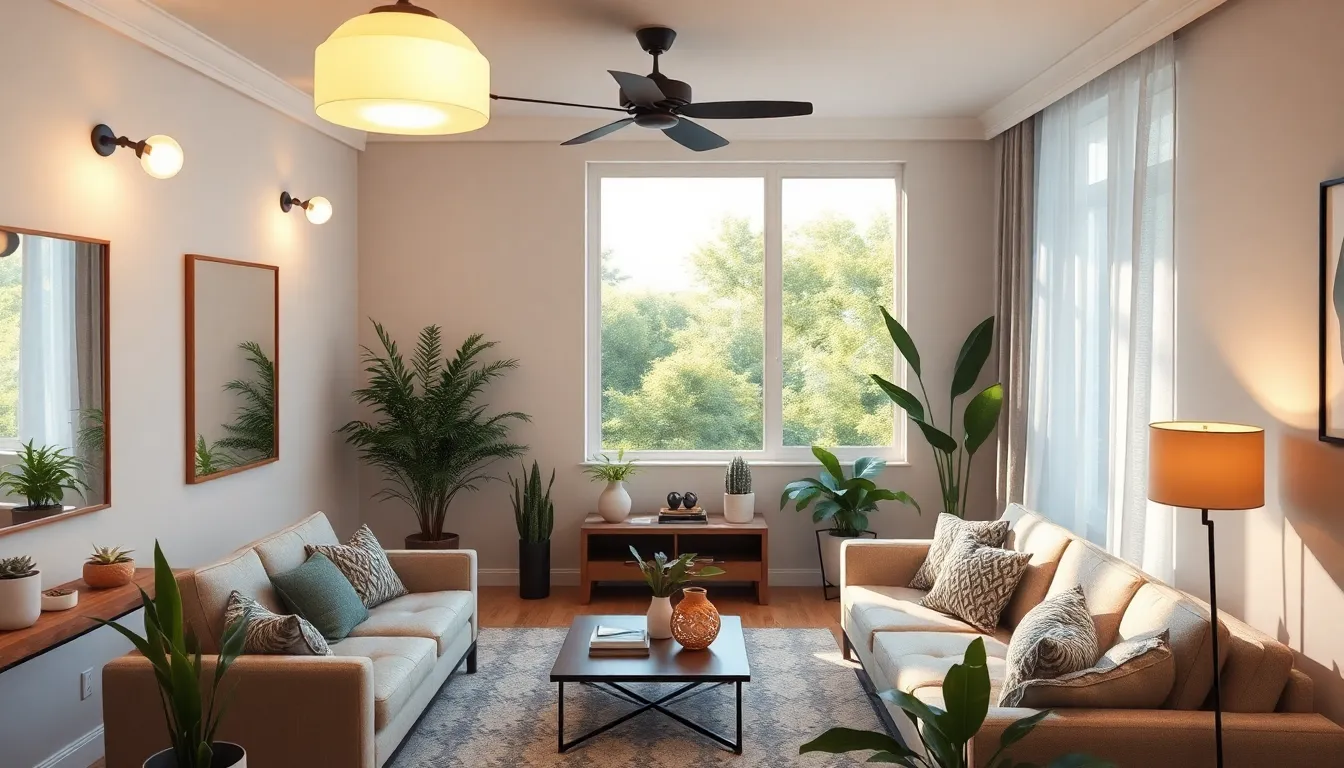
Building on our sustainable living room foundation, lighting choices play a crucial role in reducing energy consumption while maintaining the perfect ambiance for our space.
Install LED Bulbs to Reduce Electricity Consumption
LED bulbs represent the most impactful upgrade we can make to our living room lighting system. These innovative bulbs use up to 90% less energy than traditional incandescent bulbs, dramatically cutting our electricity bills while providing the same brightness levels.
Longevity becomes a important advantage when we choose LED options, with integrated LED fixtures lasting up to 50,000 hours compared to regular LED bulbs at around 3,000 hours. Investment costs recover quickly through reduced energy bills and fewer replacement purchases over time.
Smart LED systems allow us to adjust brightness and color temperature throughout the day, optimizing both energy savings and comfort levels. We’ll find these systems particularly beneficial for creating different moods while maintaining our commitment to sustainable living room practices.
Add Natural Light with Strategically Placed Mirrors
Mirrors transform our living room’s natural light potential by reflecting sunlight deeper into the space. Strategic placement near windows amplifies existing daylight, reducing our dependence on artificial lighting during daytime hours.
Positioning large mirrors opposite windows creates the most dramatic impact, effectively doubling the natural light in darker corners of our living room. We can also use smaller decorative mirrors throughout the space to bounce light around and create brighter, more welcoming atmospheres.
Room brightness increases significantly with this approach, particularly in spaces with limited window access or northern exposures that receive less direct sunlight.
Use Solar-Powered Accent Lighting
Solar powered lighting harnesses renewable energy to illuminate our living room accent features without increasing electricity consumption. These systems charge during daylight hours and automatically provide ambient lighting when the sun sets.
Battery powered solar lights work exceptionally well for highlighting artwork, plants, or architectural features where traditional wiring would be challenging or expensive to install. We’ll appreciate the flexibility of moving these lights as our decor changes throughout the seasons.
Environmental impact reduces considerably with solar options, as we eliminate our reliance on grid electricity for accent lighting while maintaining the aesthetic appeal our living room design requires.
Choose Sustainable Furniture Made from Eco-Friendly Materials
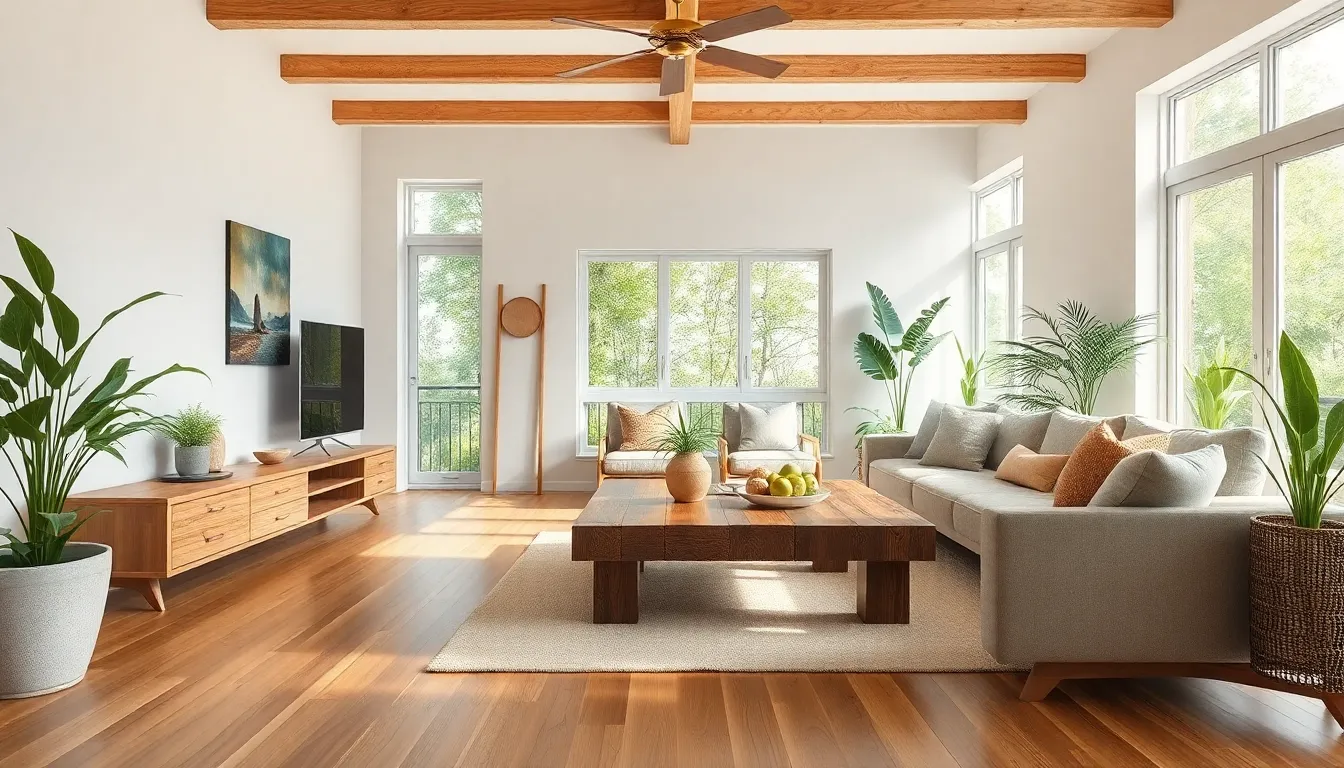
Transitioning to sustainable furniture represents one of the most impactful changes we can make in our living room design. Eco-friendly materials like natural fibers, solid wood, and low-VOC finishes create healthier indoor environments while reducing our environmental footprint.
Select Reclaimed Wood Coffee Tables and Shelving
Reclaimed wood coffee tables bring unique character and history into our living spaces while diverting materials from landfills. We can find beautiful pieces crafted from salvaged barn wood, old factory flooring, or repurposed shipping pallets that showcase distinctive grain patterns and weathered textures.
Choosing reclaimed wood shelving units maximizes both storage and sustainability by giving new life to previously used timber. These pieces often feature interesting imperfections like nail holes, saw marks, and natural aging that add visual interest to our rooms.
Searching for furniture with FSC-certified reclaimed wood ensures we’re supporting responsible forestry practices. Local artisans and vintage furniture stores frequently offer custom reclaimed wood pieces that perfectly fit our exact dimensions and style preferences.
Invest in Bamboo or Cork Flooring Options
Bamboo flooring offers exceptional sustainability since bamboo regenerates in just 3-5 years compared to traditional hardwood’s 25-50 year growth cycle. We benefit from its natural antimicrobial properties and impressive durability that rivals traditional hardwood floors.
Installing cork flooring provides excellent insulation and soundproofing while creating a comfortable walking surface that’s gentle on our joints. Cork’s cellular structure naturally resists mold, mildew, and insects without requiring chemical treatments.
Selecting strand-woven bamboo delivers the highest durability ratings among bamboo flooring options. We can choose from various finishes and colors that complement our existing decor while maintaining the eco-friendly benefits of rapidly renewable materials.
Purchase Furniture Made from Recycled Materials
Investing in furniture crafted from recycled plastic creates stunning pieces that prevent ocean waste while requiring minimal maintenance. We can find outdoor-style furniture perfect for sunrooms or casual living areas that withstand moisture and temperature changes.
Buying upholstered furniture with recycled foam filling and fabrics made from post-consumer materials supports circular economy principles. These pieces often perform better than traditional options while contributing to waste reduction efforts.
Looking for metal furniture made from recycled aluminum or steel provides long-lasting durability with significantly lower environmental impact than virgin materials. We can incorporate these pieces as accent tables, storage answers, or statement lighting fixtures that enhance our green living room design.
Implement Natural Color Schemes with Green Paint and Decor
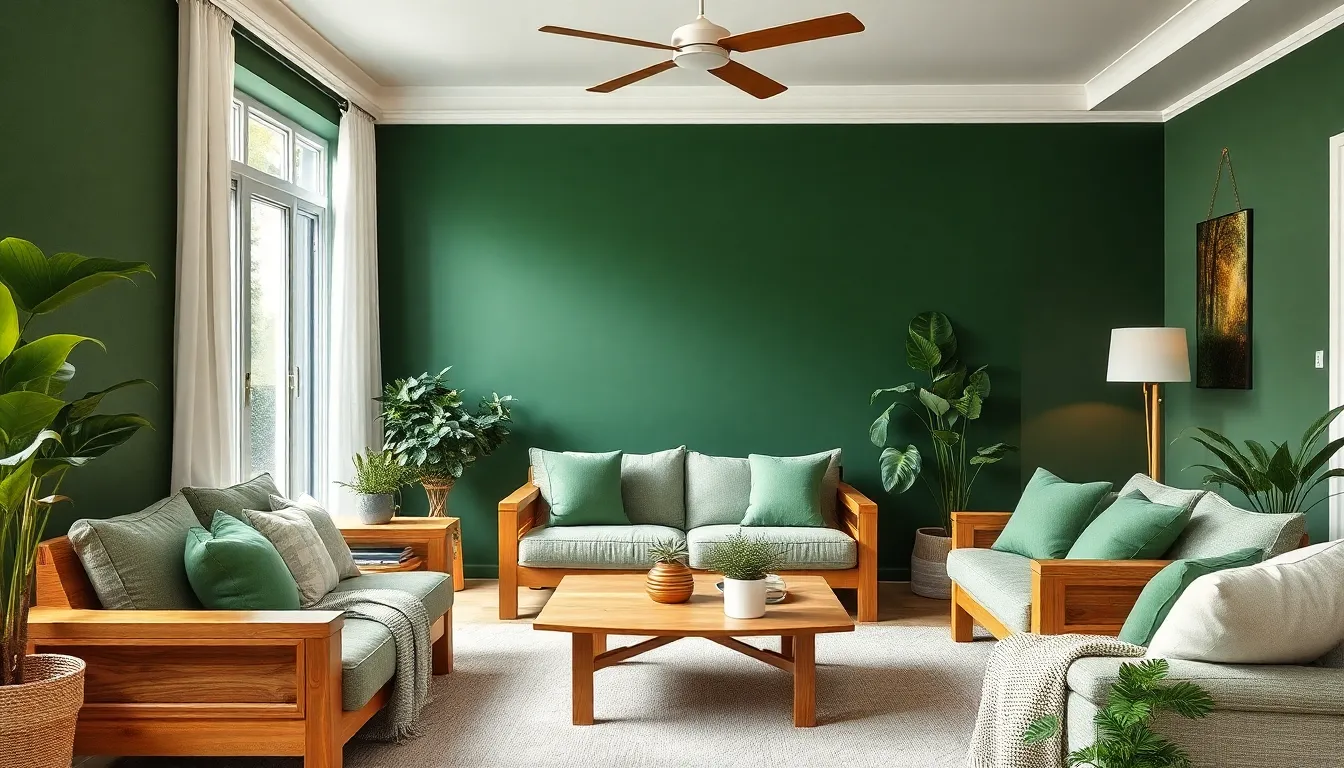
Building on sustainable living room foundations, we can transform our spaces using green color schemes that bring natural tranquility indoors. These natural hues create the perfect bridge between eco-conscious design and aesthetic appeal.
Paint Accent Walls in Earth-Tone Green Shades
Rich earthy green tones on accent walls add immediate depth and sophistication to our living rooms. We recommend painting floor-to-ceiling built-in shelving or a single statement wall in deep forest green or warm olive shades to create a stunning backdrop for decorative objects.
Bold green accents work best when we balance them with neutral colors like cream, beige, or soft gray. This approach prevents the space from feeling overwhelming while maintaining that natural connection we’re seeking.
Color drenching techniques allow us to paint walls, built-ins, moldings, and even ceilings in unifying green shades for a cohesive, immersive experience. This method creates visual continuity that makes our living rooms feel larger and more harmonious.
Add Green Throw Pillows and Organic Cotton Textiles
Green throw pillows offer us the perfect way to introduce natural colors without committing to painted walls. We can easily swap these accessories seasonally or when our design preferences evolve.
Layered textures using organic cotton textiles in various green shades create visual interest and comfort. Mix different fabrics like linen, cotton, and wool in complementary green tones to achieve a sophisticated, organic feel.
Combining green textiles with blue accents produces a serene and harmonious atmosphere reminiscent of natural landscapes. This color pairing works particularly well in living rooms where we want to promote relaxation and calm.
Display Natural Wood and Stone Decorative Elements
Natural wood furniture and stone decorative elements enhance the earthy ambiance that green color schemes create. We can incorporate reclaimed wood coffee tables, live-edge shelving, or wooden accent pieces to reinforce our sustainable design goals.
Stone elements like marble bookends, granite plant stands, or river rock collections add textural contrast against green backgrounds. These materials provide grounding elements that make our living rooms feel connected to nature.
Houseplants and green installations serve as living decorative elements that emphasize our natural theme while improving indoor air quality. We can position plants strategically near green accent walls to create layered green tones that feel intentional and sophisticated.
Use Eco-Friendly Cleaning Products and Air Fresheners
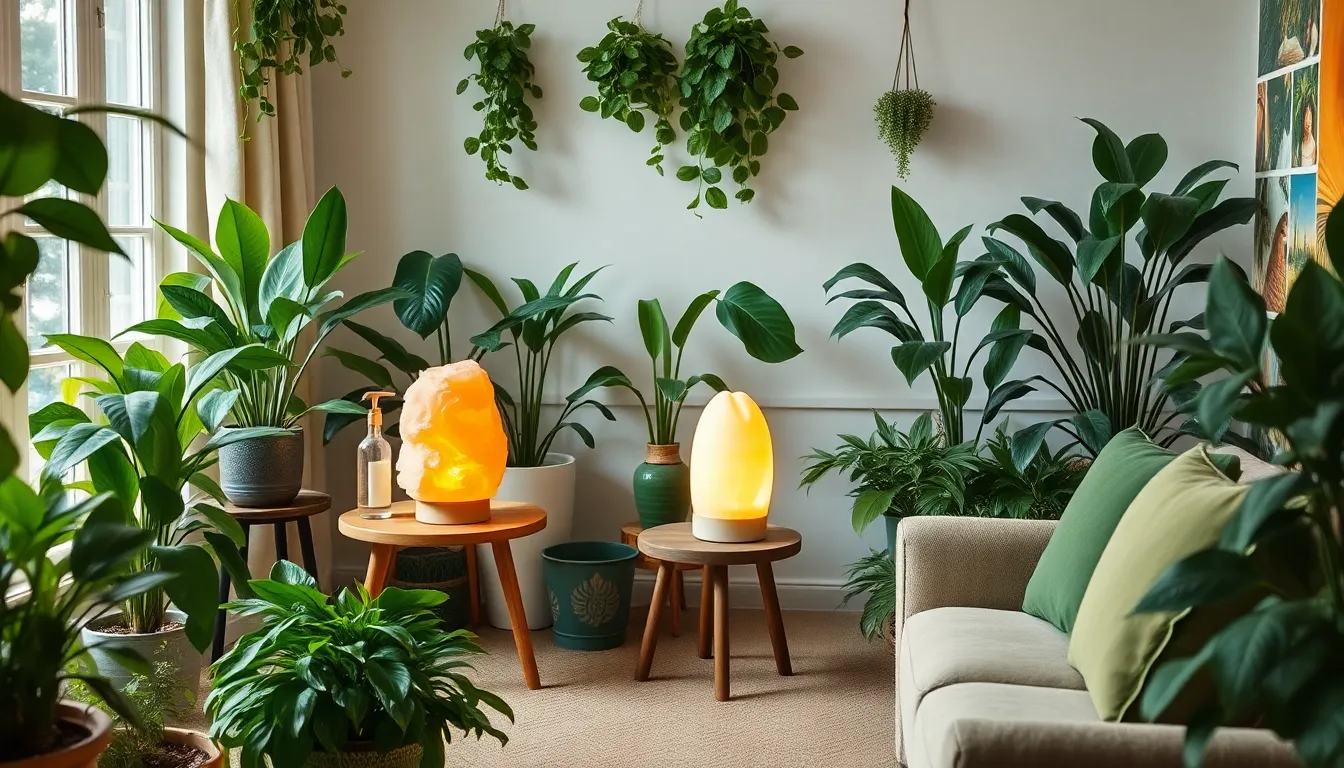
Natural cleaning answers transform our living spaces while protecting both our health and the environment. We’ll explore simple swaps that eliminate harmful chemicals from our homes.
Replace Chemical Cleaners with Natural Alternatives
Baking soda serves as our most versatile cleaning powerhouse for tackling tough stains and odors throughout the living room. We can sprinkle it directly onto carpets before vacuuming to neutralize pet odors and refresh fabric surfaces naturally.
Vinegar cuts through grease and grime on glass surfaces like coffee tables and entertainment centers without leaving chemical residues. Mix equal parts white vinegar and water in a spray bottle for an effective all-purpose cleaner that costs pennies per use.
Lemon juice brightens and disinfects wooden furniture while leaving behind a fresh citrus scent that doesn’t trigger allergies. We recommend combining lemon juice with olive oil to create a natural wood polish that nourishes and protects our sustainable furniture pieces.
Castile soap provides gentle yet effective cleaning power for upholstery and fabric surfaces without harsh detergents. Add a few drops to warm water for spot cleaning throw pillows and organic cotton textiles without damaging delicate fibers.
Create DIY Air Fresheners Using Essential Oils
Essential oil diffusers distribute natural fragrances throughout our living spaces without synthetic chemicals or aerosol propellants. We can customize scent combinations using lavender for relaxation or eucalyptus for an energizing atmosphere that complements our green color schemes.
Reed diffusers offer continuous fragrance release using natural carrier oils and bamboo reeds that align with our sustainable design choices. Simply combine your favorite essential oils with a carrier oil like sweet almond or jojoba in a decorative glass container.
Potpourri sachets tucked behind throw pillows or placed on bookshelves provide subtle, long-lasting fragrance using dried herbs and flowers. We suggest creating seasonal blends with rosemary, dried citrus peels, and cinnamon sticks for a natural aromatic experience.
Baking soda air fresheners absorb odors while releasing gentle scents when combined with essential oils. Mix 1/2 cup baking soda with 10-15 drops of essential oils in small bowls placed strategically around the room for continuous odor elimination.
Maintain Indoor Air Quality with Himalayan Salt Lamps
Himalayan salt lamps purify the air by releasing negative ions that neutralize pollutants and allergens in our living spaces. These natural air purifiers complement our indoor plants by creating a dual filtration system that improves breathing quality.
Strategic placement near electronics and seating areas maximizes the air purifying benefits while providing warm ambient lighting. We recommend positioning salt lamps on side tables or shelving units where they can effectively circulate ions throughout the room.
Regular maintenance involves wiping the salt surface with a damp cloth to remove dust and maintain optimal ion production. Keep lamps away from high humidity areas to prevent excessive moisture absorption that can damage the salt crystal structure.
Multiple smaller lamps distributed throughout the room prove more effective than single large units for comprehensive air purification. Choose lamps with dimmer switches to control brightness levels while maintaining consistent air cleaning benefits during both day and evening hours.
Install Smart Home Technology for Energy Conservation

Smart home technology transforms living rooms into energy efficient spaces by automating systems that traditionally waste power. We can reduce our home’s energy consumption by up to 27% through strategic implementation of intelligent devices that learn our habits and optimize usage patterns.
Program Smart Thermostats to Optimize Heating and Cooling
Smart thermostats deliver substantial energy savings by learning our daily schedules and adjusting temperatures automatically. Programming these devices to lower heating when we’re away or asleep creates utility bill reductions ranging from 5% to 22%, according to energy efficiency studies. We’ll find that these systems turn off heating completely when rooms are empty and gradually adjust temperatures during periods of inactivity.
Modern smart thermostats connect to our smartphones, allowing remote temperature control that prevents unnecessary energy use. Setting temperature schedules around our work patterns ensures we’re not heating or cooling empty spaces throughout the day. Advanced models can even detect when we’re approaching home and begin adjusting temperatures accordingly, maintaining comfort while maximizing efficiency.
Use Smart Power Strips to Eliminate Phantom Energy Draw
Smart power strips cut off electricity to devices automatically, eliminating “phantom” energy consumption that occurs when electronics remain plugged in. Television sets, computers, and gaming consoles continue drawing power in standby mode, creating unnecessary energy waste that smart strips prevent. We can save substantial amounts on our electricity bills by addressing this hidden energy drain that affects multiple devices simultaneously.
These intelligent strips detect when primary devices shut down and automatically cut power to connected peripherals like speakers, printers, and chargers. Programming options allow us to customize which outlets remain active and which ones switch off based on our usage patterns. Remote control capabilities enable us to turn off entire entertainment centers or office setups from anywhere in our home.
Install Motion-Sensor Lighting for Automatic Energy Savings
Motion sensor lighting eliminates energy waste by turning lights on and off based on room occupancy automatically. Installing these sensors in our living room ensures lights never remain on unnecessarily, leading to important energy savings in frequently used spaces. We’ll benefit from hands free lighting control that responds instantly to our presence while conserving power when we’re elsewhere.
Smart motion sensors can distinguish between pets and people, preventing false activations that waste energy. Adjustable sensitivity settings allow us to customize detection ranges and timing delays to match our living room’s exact layout and usage patterns. Advanced sensors integrate with existing smart home systems, enabling us to monitor energy savings and adjust settings through mobile apps for optimal efficiency.
Repurpose and Upcycle Existing Items for Sustainable Decor
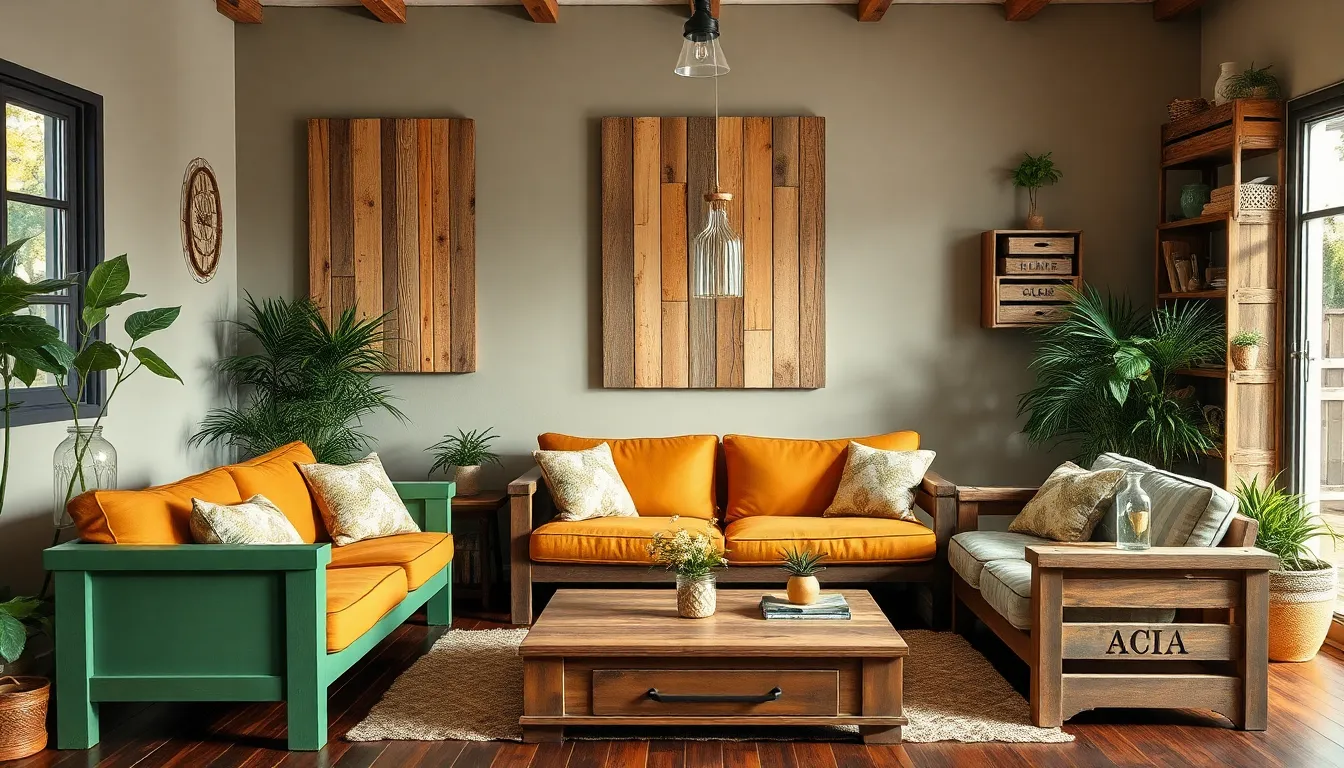
Transforming existing items into functional decor pieces reduces waste while creating unique living room elements. Upcycling projects help us minimize our environmental impact while maximizing our creativity and budget.
Transform Old Furniture with Eco-Friendly Paint
Revitalizing old furniture with eco-friendly paint breathes new life into worn pieces while avoiding landfill waste. Non-toxic paints made from natural ingredients eliminate harmful VOCs that can compromise indoor air quality.
We recommend selecting milk paint or clay-based formulas that offer excellent coverage without synthetic chemicals. Chalk paint provides another sustainable option that requires minimal preparation and creates beautiful matte finishes. Natural pigments derived from minerals and plants deliver rich colors while maintaining environmental safety.
Refinishing wooden chairs, tables, and dressers with these eco-friendly options costs significantly less than purchasing new furniture. The process typically involves light sanding, primer application, and two coats of natural paint for optimal durability.
Create Storage Answers from Recycled Containers
Repurposing everyday containers into storage answers eliminates the need for plastic organizers while adding character to our living spaces. Mason jars work perfectly for holding remote controls, charging cables, and small decorative items on coffee tables and shelves.
Large cardboard boxes can be transformed into stylish storage cubes by covering them with fabric or natural fiber wrapping. Wine crates and wooden fruit boxes make excellent open shelving units when mounted on walls or stacked horizontally.
Glass containers like pickle jars and yogurt containers provide transparent storage for create supplies, batteries, and office materials. We can enhance their appearance by removing labels and adding natural twine or cork wrapping for a rustic aesthetic.
Design Wall Art Using Natural and Reclaimed Materials
Creating wall art from reclaimed wood, bamboo, and cork adds texture while supporting sustainable design principles. Weathered barn wood arranged in geometric patterns creates striking focal points that complement green living room themes.
Bamboo stalks can be cut into varying lengths and mounted in vertical or horizontal arrangements for modern botanical displays. Cork boards fashioned from wine cork collections provide functional wall art that doubles as memo boards or photo displays.
Driftwood pieces collected from beaches or reclaimed from construction sites can be arranged into abstract sculptures or mounted as natural shelving. These materials cost little to nothing while creating one-of-a-kind pieces that reflect our commitment to environmental responsibility.
Stone and river rock arrangements mounted in shadow boxes bring natural textures indoors while showcasing collected treasures from outdoor adventures.
Conclusion
We’ve shown you that creating an eco-friendly living room isn’t just about making responsible choices – it’s about designing a space that truly reflects our values while improving our daily lives. From energy-efficient lighting to sustainable furniture and natural color schemes we can transform our living spaces without sacrificing style or comfort.
The beauty of green living room design lies in its flexibility. Whether we’re ready for major renovations or prefer simple swaps like adding plants or switching to natural cleaners every step counts toward a more sustainable future.
Our living rooms can become showcases for environmental responsibility while maintaining the warmth and functionality we love. Start with one or two changes that resonate with you and watch as your space evolves into a healthier more sustainable haven for you and your family.
Frequently Asked Questions
What are the main benefits of creating a sustainable living room?
Sustainable living rooms offer multiple advantages including reduced carbon footprint, lower energy bills, improved indoor air quality, and enhanced aesthetic appeal. By choosing eco-friendly materials and energy-efficient solutions, you can create a healthier living environment while saving money on utilities and supporting environmental conservation efforts.
Which indoor plants are best for beginners in sustainable living rooms?
Low-maintenance plants ideal for beginners include snake plants, pothos, ZZ plants, peace lilies, spider plants, rubber trees, and aloe vera. These plants require minimal care while effectively purifying indoor air and adding natural beauty to your living space.
How much energy can LED lighting save compared to traditional bulbs?
LED bulbs use up to 90% less energy than traditional incandescent bulbs and last significantly longer. This dramatic reduction in energy consumption leads to lower electricity bills and fewer bulb replacements, making LEDs both environmentally friendly and cost-effective for sustainable living rooms.
What sustainable materials should I look for when buying furniture?
Choose furniture made from natural fibers, solid wood with low-VOC finishes, FSC-certified reclaimed wood, bamboo, cork, or recycled materials like plastic and metal. These eco-friendly materials promote healthier indoor environments while reducing environmental impact and supporting responsible manufacturing practices.
How can smart home technology improve energy efficiency in living rooms?
Smart thermostats can reduce energy consumption by up to 27% by learning your habits and optimizing heating and cooling. Smart power strips eliminate phantom energy draw, while motion-sensor lighting automatically adjusts based on room occupancy, significantly improving overall energy efficiency.
What natural cleaning alternatives can replace chemical products?
Effective natural cleaning alternatives include baking soda for scrubbing, white vinegar for disinfecting, and lemon juice for removing stains and odors. These ingredients clean effectively without harmful residues, protecting both your health and the environment while maintaining a fresh living space.
How can I incorporate green color schemes without major renovations?
Add green hues through accent walls painted in earthy shades, green throw pillows, organic cotton textiles, and strategically placed houseplants. Balance bold green colors with neutral tones to maintain harmony while introducing natural elements that enhance tranquility and air quality.
What are creative ways to repurpose items for sustainable decor?
Transform old furniture with eco-friendly paints like milk paint or chalk paint, create storage solutions from mason jars and cardboard boxes, and design wall art from reclaimed wood or bamboo. These upcycling projects reduce waste while adding unique character to your living room.







